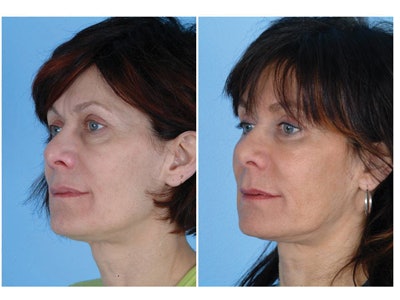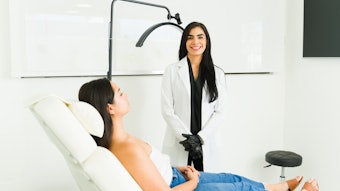
Trends in the cosmetic field are changing rapidly, and the increased popularity of cosmetic medical treatments may cause estheticians to become concerned about losing some of their business.
However, the opposite is true; this is a golden opportunity for increasing your education and broadening your client base. There are many ways that you can assist with cosmetic medical procedures. Patients appreciate the extra attention to detail that can be provided through the expertise of an esthetician, and they often become regular clients of the esthetician who assists them with these treatments.
Skin rejuvenation
Skin rejuvenation is a process that helps decrease the visible signs of aging, including photodamage, fine lines, wrinkles, and loose or sagging skin. There are many methods used to provide skin rejuvenation, including surgery, cosmetic fillers, neurotoxin inhibitors and laser rejuvenation. There are several lasers to choose from for skin rejuvenation, such as intense pulsed light (IPL), visible light lasers and ablative lasers. IPL and visible light lasers are more commonly used for removing discolorations on the skin, such as pigmentation or telangectasia. Ablative laser treatments can be beneficial for all signs of aging, including pigmentation, fine lines, wrinkles and loose skin caused by a reduction of collagen.
Fractionated carbon dioxide (CO2) lasers are becoming the latest trend for skin rejuvenation. These lasers use a long wavelength of energy that is absorbed by water in the skin. CO2 lasers rejuvenate by destroying the outermost—and most photodamaged—layers of the skin.
During CO2 laser treatments, heat travels locally in a controlled manner to the deep dermal reticular layer. The generated heat changes the shape of dermal protein, such as collagen, which causes an immediate tightening. Although the results are great, traditional CO2 lasers remove the entire epidermis and papillary layer of the dermis, leaving the skin requiring six weeks of downtime for healing. The extended recovery needed for this treatment, in addition to the substantial risk for complications, such as hypopigmentation and scarring, have resulted in the development of fractionated lasers.
A fractionated laser procedure is performed with a CO2 laser that uses a fractioned pattern over the surface of the treatment area. This means that only portions of the skin are treated, leaving healthy skin left untreated in order to promote quicker healing and provide optimal collagen production. This procedure provides better results in treating aged, sun-damaged and scarred skin with a reduced risk of complications. Although it may take up to six months to see full results following a fractionated laser treatment, there are usually only five to seven days of downtime compared to the six weeks associated with the traditional CO2.
The esthetician’s role. Clients’ skin can be prepared for this procedure by recommending the proper products to use before the treatment, as well as after. Consider recommending a skin resurfacing kit that includes an anti-inflammatory cleanser, collagen-stimulating products, a skin-lightening cream to prevent hyperpigmentation and zinc-oxide based sun protection. Patients will see optimal results by using these products for at least a week before the treatment, with continued use for two to three weeks after the skin has re-epitheliazed. The most critical time for patients to care for their skin is the five to seven days immediately following the treatment. You must reiterate the importance of keeping the skin well protected with an occlusive moisturizing agent—this is a critical time in the healing process, and skin may not heal properly if it is not kept in a moist environment. Patients should be advised to use a mild, hypoallergenic cleanser as needed, and that a physical sunscreen is mandatory. If patients do not use SPF 30+ sunscreen following the procedure, they are at risk for hyperpigmentation or even scarring if exposed to the sun. At the three-week post-procedure appointment, an ultrasound treatment can be performed to penetrate hydrating agents into the skin, as well as increase circulation to speed healing. At this point, it is important to recommend products to maintain the results received from the treatment.
Cheek enhancement
Straight from the runways to the faces of women throughout the country, the latest craze is all about the cheeks. Strong, well-defined cheekbones have been seen as a symbol of beauty and femininity for decades and now, thanks to fillers, women can take years off by subtly defining their cheeks. Correction of the mid-face represents a shift in the way surgeons approach treating patients. The ideal face shape is an inverted triangle, but as women age, sagging jowls can cause the opposite effect. Early facial rejuvenation techniques pulled the skin, often resulting in the artificial “windblown” appearance. New methods available today focus on correcting volume loss to the middle portion of the face. The treatment is quick and easy to perform. Patients are often numbed with a topical agent or a nerve block so the treatment is more comfortable, followed by a few quick injections on each side of the face where results are immediately visible as the cheek is being sculpted. Nonsurgical cheek augmentation is for females of all ages, not just to look younger, but to give the face definition.
The esthetician’s role. Following a treatment of filler in the cheeks, a vitamin K oxide-based moisturizer post-op gel may be applied to reduce the risk of bruising at the injection sites. The gel has been shown to decrease the life of bruises by reducing pooled blood that can accumulate following injury to the skin. If bruising does occur, camouflage makeup can be recommended. To apply to makeup, begin by whitewashing the area or the whole face with a color that is lighter than the skin. This is followed by the application of a contrasting color of concealer to the bruised area; for example, if the bruise is blue, the esthetician can conceal it with orange, and if the bruise is yellow, it can be concealed with a light lilac purple. To finish, cover the entire face with the correct color of foundation powder to set the concealer and provide even coverage.
You can also teach patients how to apply cosmetics in order to accentuate the appearance of their new cheek enhancements. This is done by highlighting the highest part of the cheek, and then shading or darkening the area right underneath the cheekbone, giving the illusion of a more structured and defined cheek. Naturally, light will be attracted to the lighter color and give depth to the darker color. The hues should differ from the patient’s natural base color; the lighter color should be more iridescent, and the darker shade should be a matte bronze color or a foundation that is one to two shades darker than the skin tone.
Stay ahead of the trends
Estheticians must stay abreast of what is happening in the medical aesthetic industry. It is a dynamic field that offers a diverse opportunities. These new treatments are becoming increasingly popular and it is crucial to be aware of them and learn how to integrate them into their business. This will enable you to stay ahead of new trends in the industry.











